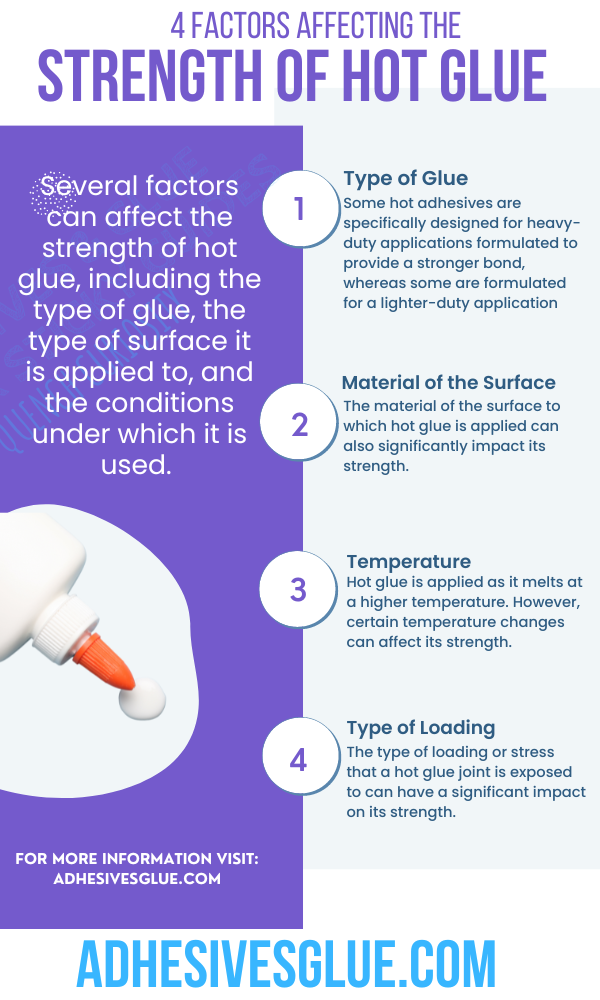Hot glue sounds like a super strong adhesive that can help us in various activities. But, exactly how much weight can hot glue hold? What exactly is the strength of hot glue?
The amount of weight hot glue can hold will vary depending on the type of glue and the surface it is applied to. The average weight limit of hot glue was determined to be 2-3 pounds after a series of tests were conducted.
These tests determined the strength of hot glue by changing several key factors; type of surface, temperature, material, and the type of glue being used.
Some of us were probably introduced to hot glue through the art and crafts channel. However, hot glue is a type of adhesive that is used for a variety of purposes, such as crafting, home repairs, and DIY projects.
It is important to note that this is just a general estimate, and the actual weight hot glue can hold will depend on the specific circumstances of each case.
In this blog, we will explore the factors that may impact its strength. We will also provide a few tips on improving the strength of hot glue.
Contents
4 Factors Affecting the Strength of Hot Glue
Several factors can affect the strength of hot glue, including the type of glue, the type of surface it is applied to, and the conditions under which it is used.
Let’s take a closer look at each of these factors in more detail.
1. Type of Glue
The strength of hot glue can vary greatly, depending on the glue you use.
For example, some hot adhesives are specifically designed for heavy-duty applications (for example, woodwork) and are formulated to provide a stronger bond.
Other hot adhesives are designed for lighter-duty applications (for example, arts and crafts) and might not be strong. If you choose a weaker glue for heavy-duty projects, the strength of the glue will not deliver the required results.
2. Material of the Surface
The material of the surface to which hot glue is applied can also significantly impact its strength. Hot glue works best on materials such as fabric, wood, glass, and paper.
However, there are certain materials or surfaces, that hot glue will not work on, such as metal, oil or grease, plastic, and water. The type of surface is also a determinant when it comes to the strength of hot glue.
If the surface is porous or rough, it will create a stronger bond than the smoother surface by getting in the crevices.
For example, when hot glue is applied on the glass surface, it can be removed after drying, but when it is applied on the rougher edges, it will be stronger than the smoother side of the glass.
3. Temperature
As the name suggests, hot glue is applied as it melts at a higher temperature. However, certain temperature changes can affect its strength. There are varieties of hot glue, each having its melting point.
It is essential to consider that the temperature of hot glue shouldn’t be higher than recommended. Humidity in the air can also impact the strength of hot glue.
4. Type of Loading
The type of loading or stress that a hot glue joint is exposed to can have a significant impact on its strength.
Hot glue is typically stronger in compression than in tension, so it may not be suitable for applications where the joint will be subject to pulling forces.

5 Ways to Improve the Strength of Hot Glue
Now that we have determined the possible factors that can affect its strength, let’s see how we can improve it.
Here are 5 popular ways you can improve the strength of your hot glue. Let’s look at some of these tips in more detail.
1. Choose the Right Type of Glue
As mentioned above, not all hot glues are created equal, and the strength of hot glue can vary greatly depending on the glue you use. Some hot adhesives are specifically formulated for heavy-duty applications and are stronger than others.
It is important to choose the right type of glue for the projects. Paper or cardboard surfaces can be worked on, using weaker hot glue, however, woodwork requires a specific and heavy-duty hot glue.
If you need a strong bond, choose a hot glue that is specifically designed for heavy-duty applications. However, it does not mean that weaker glue is bad. Different hot adhesives are manufactured for different surfaces and purposes.
For example EVA (Ethylene Vinyl Acetate) based glue is generally used for papers or manufacturing and packing products. In contrast, Polyamide based hot glue is used for more heavy-duty work such as woodwork or electrical appliances.
2. Prepare the Surface
As mentioned above, the type of surface can greatly impact the strength of hot glue. To get the best possible bond, make sure to clean and prepare the surface before applying the hot glue.
This will remove any dirt, dust, or other debris that may weaken the bond. Additionally, it’s a good idea to roughen up the surface slightly with sandpaper, as this will create a better surface for the hot glue to adhere to.
3. Allow Adequate Time for Drying
Hot glue needs time to dry and set, and the length of time it takes will depend on the conditions and the type of glue you’re using. Be sure to allow enough time for the hot glue to dry before exposing it to weight or stress.
If you’re in a hurry, consider using a quick-drying hot glue, or using a fan to speed up the process.
4. Application Method
Though it may seem unnecessary, the method of application can also impact the strength of the hot glue bond.
To maximize the strength of hot glue, it’s best to apply multiple dots of hot glue, rather than a single continuous line, as this will help distribute the weight more evenly and reduce the risk of the bond breaking under stress.
Additionally, applying hot glue in a zigzag pattern can also help to increase bond strength. Using more hot glue can also improve its strength.
When applying hot glue, use a generous amount and apply it in a continuous bead, rather than just a few dots. This will help distribute the weight more evenly and provide a stronger bond.
However, using too much glue can take more time to dry, thus weakening the bond between the glue and the surface.
5. Call for Reinforcements!
Using additional support, such as tape or wire, can also help improve the strength of hot glue.
For example, if you’re using hot glue to bond two pieces of wood together, you can reinforce the bond by tying a piece of wire around the joint, or by wrapping tape around the joint.
This will help distribute the weight more evenly and prevent the joint from breaking under stress.
Conclusion
Hot glue is a versatile and convenient adhesive that is commonly used for a variety of projects.
However, certain variables can weaken its strength, such as the type of glue, quality, material, and surfaces. If you want to improve the strength of hot glue, there are several tips you can follow.
You can improve the strength by choosing the right type of glue, preparing the surface, allowing adequate time for drying, applying more glue, and using reinforcements.
By following these tips, you can help ensure that your hot glue projects will be stronger and more durable.

I fell in love with crafts & fixing things when I was 11 years old – after discovering the world of blogging, I am combining my passions to present the world with well-researched guides & reviews about everything related to adhesives & glue.
